A. Mars is Now in Scorpius
New Year opened, the Planet Mars has moved from Libra to Scorpius, shining low in the southeastern dawn sky. The red planet went through 5 degrees north of its rival Antares to go on prograding. During January the apparent diameter remains as small as 4 arcsecond range, with the unstable winter atmosphere, northern hemisphere observers may have hard time to capture the planetary details.
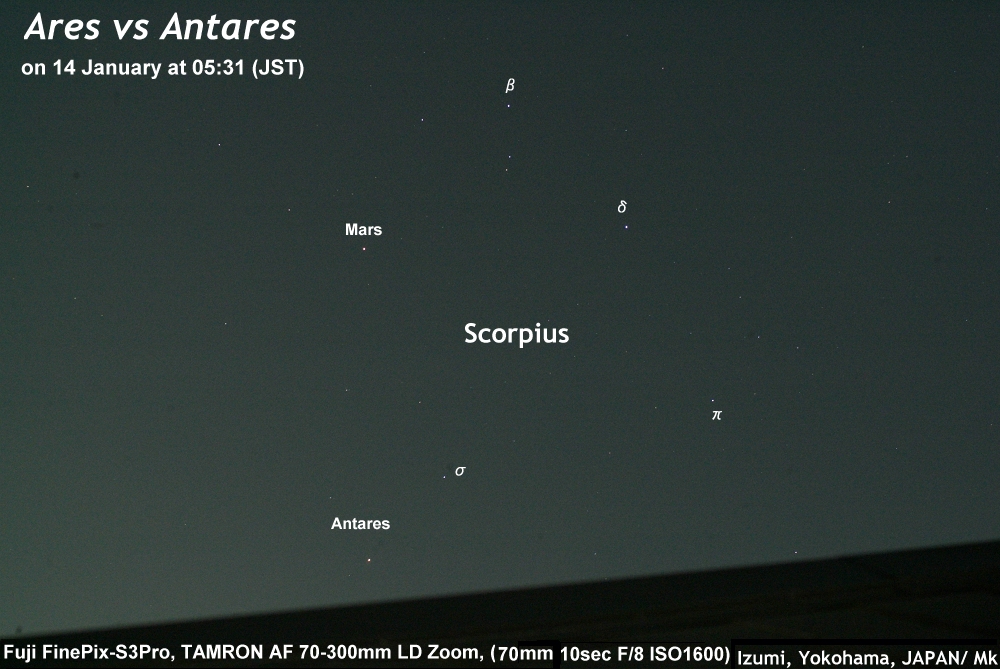
B. Now in a Favorable Mars Observing Period
Now in June, Mars is prograding in Aquarius, passed by Neptune on 12 June to go on heading towards Pisces. Mars' declination goes over 10°S to
shine high in the dawn sky in the northern hemisphere, with apparent
diameter surpassed 10 arc seconds by 12 June, appropriate to enjoy
observing. The red planet now rises earlier, getting able to observe at
around 2 o'clock AM local time.
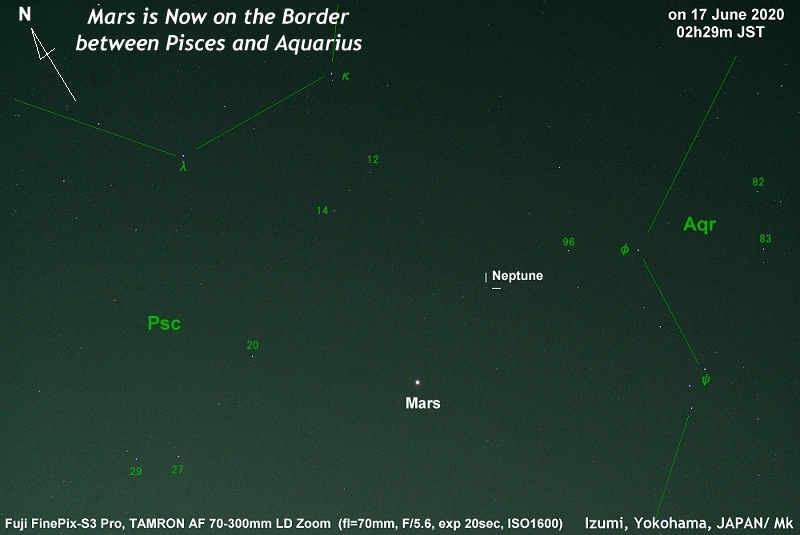
Martian season has already passed southern vernal equinox (λ=180°Ls ) to reach λ=220°Ls to show the interesting aspects of subliming/shrinking South Polar Cap. And the season is also for the dust event occurrence, requiring careful constant systematic observation rhythm to enable daily comparison with identical central meridian.
C. Mars is Getting Closer
Entering into September, aiming to reach the closest approach in this apparition on 06 October, Mars shifts to retrograding in Pisces after passing the stationary point on 06 September, approaches to the Earth along the reverse S-shaped motion in the sky as shown in the figure. During September, declination (Decl) of the red planet stays in the 6° to 7° N range. As the local culmination altitude (Alt) is [ Alt=90°-(Local Lat.)+Decl ] , it will reach as high as 60° in Tokyo.
Mars' apparent diameter goes over 20 arcseconds by 08 September, allows the observers in the northern hemisphere to observe it under most favorable conditions for the first time in forever! The 20 arcseconds range holds almost 50 days to the first day of November.
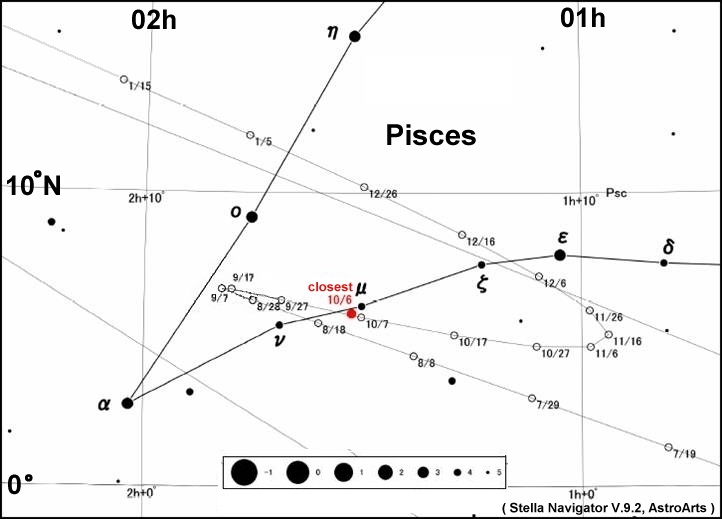
Recent remarkable advance in imaging/processing technology enabled us to take stunning quality of ground based planetary images. So hereafter, we would be checking submitted Mars images with great expectation and surprise.
According to the Meeus Astronomical table, we have to wait the next over 20 arcseconds apparent diameter approach of Mars until 2033 opposition ; Enjoy your Mars observation in this precious apparition.
D. Detection of the shadow of AMEC
Reading the article in Space Weather dated 24 October reporting "a dark streak in the Tharsis volcanic plateau", we reviewed the Mars images submitted to us, and found a couple of observers including Robert HEFFNER (Osaka, Japan) recorded similar shady streaks. Presented here is a WinJuposly prepared development view from the HEFFNER's image :
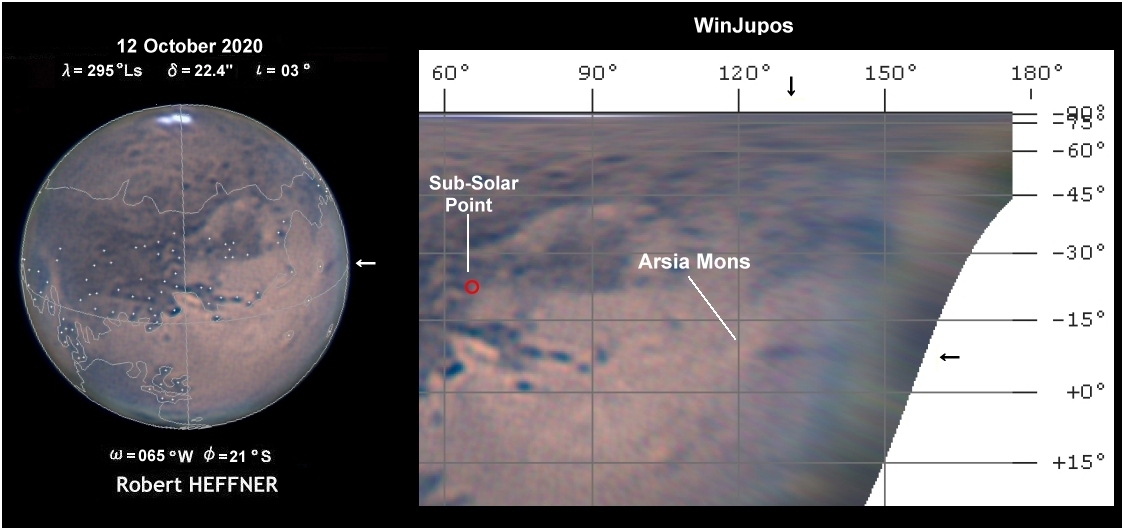
As seen in the image, an obvious dark streak is extending westward from Arsia Mons ( 121° W, 09° S) toward the dawn terminator. According to Reiichi KONNAI, this is the shadow of AMEC or Arsia Mons Elongated Cloud (named by Europian Space Agency). Also, Humitake WATANBE of Nayoro Observatory on 10 October and Yasunobu YOSHIZAWA of Fukui Observatory on 13 October clearly captured the phenomenon on their images respectively : please refer to our 2020/21 Mars Gallery.
SpaceWeather : https://www.spaceweather.com/archive.php?view=1&day=24&month=10&year=2020
This meteorological phenomenon has been repeatedly observed since 2007 by ESA's Mars Express satellite's Visual Monitoring Camera (VMC). And the feature has also been recorded by visual, photographic and digital imaging ground-based observers since 1971. It seems that AMEC occurs almost daily (Martian) in the period λ=230°~305°every Martian year.
One of the pioneering investigation of this orographic event was by Mike Malaska in 2009 :
https://www.slideshare.net/esaops/2-july-2009-arsia-mons-cloud-observed-by-the-mexvmc-instrument-1752209
Besides some miscalculations for the dimensions of the elongated cloud, the contents and the discussions are still valid.
E. A Dust Storm Occurrence at the Southern Early Fall (after λ=300°~Ls )
On this 12 November 2020, many observers in Japan announced the occurrence of a dust storm near Chryse, which had been anticipated by the possible forerunning small but very bright dust event observed at Juventae Fons on this 05 November.
The daily appearance of the initial phase of this dust storm looked just like the one occurred at exactly the same place in
October 2005. Here we show you a montage comparing the images of initial three days of the dust event in 2005 and in 2020.
The dust activity seems to be significantly influenced by the local topography.
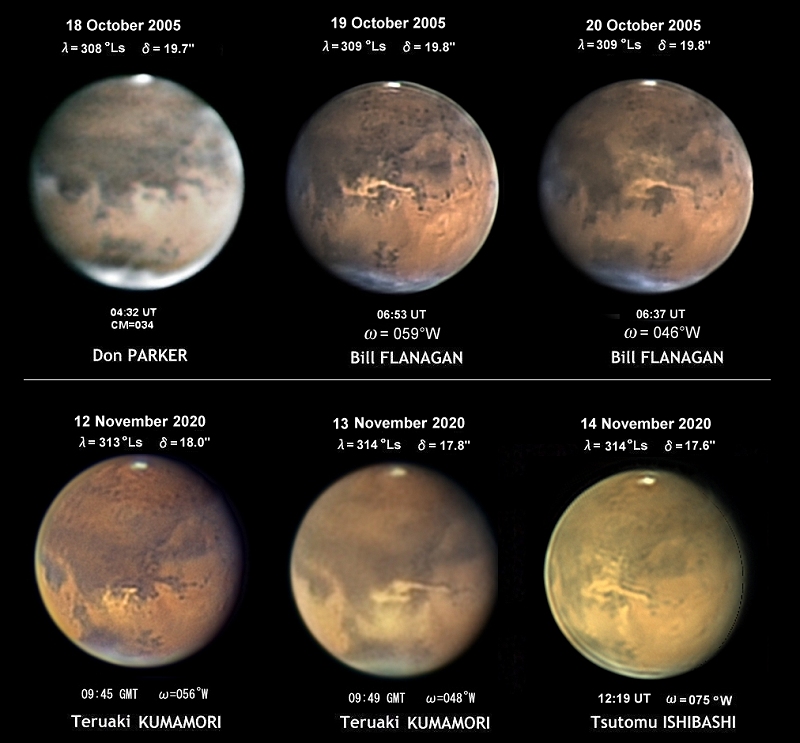
In the case of 2005, the dust storm spread over the region around Solis Lacus, easterly along Sinus Meridiani onto eastern Noachis as well, showing noticeable activity, though haven't developed to global scale. Should be paid attention to in the future progress of the present dust storm.
It was since July 2003 that we could favorably chase the very initial activity of a large dust storm from our Asia-Pacific longitudes.
Please refer to the report for the dust activity in the latter half of October and the first half of November in 2005:
https://www.kwasan.kyoto-u.ac.jp/~cmo/cmomn2/CMO312.pdf
https://www.kwasan.kyoto-u.ac.jp/~cmo/cmomn2/CMO313.pdf